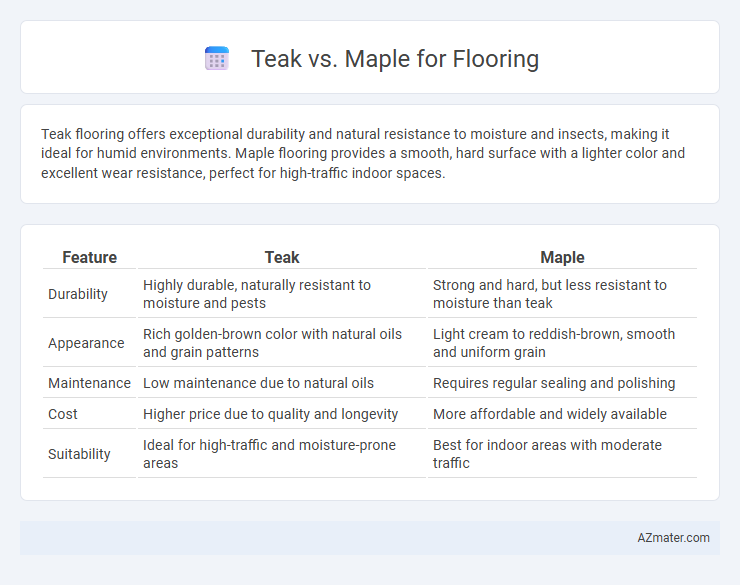Teak flooring offers exceptional durability and natural resistance to moisture and insects, making it ideal for humid environments. Maple flooring provides a smooth, hard surface with a lighter color and excellent wear resistance, perfect for high-traffic indoor spaces.
Table of Comparison
| Feature | Teak | Maple |
|---|---|---|
| Durability | Highly durable, naturally resistant to moisture and pests | Strong and hard, but less resistant to moisture than teak |
| Appearance | Rich golden-brown color with natural oils and grain patterns | Light cream to reddish-brown, smooth and uniform grain |
| Maintenance | Low maintenance due to natural oils | Requires regular sealing and polishing |
| Cost | Higher price due to quality and longevity | More affordable and widely available |
| Suitability | Ideal for high-traffic and moisture-prone areas | Best for indoor areas with moderate traffic |
Introduction to Teak and Maple Flooring
Teak flooring is prized for its durability, natural oils, and rich golden-brown color that resists moisture and insects, making it ideal for high-traffic or humid areas. Maple flooring features a lighter, creamy hue with a fine, consistent grain, known for hardness and resistance to wear, often preferred for modern and minimalist interiors. Both hardwoods offer strong performance and aesthetic appeal, but teak's tropical origin provides superior weather resistance compared to maple's temperate growth environment.
Wood Characteristics: Teak vs Maple
Teak flooring is renowned for its exceptional durability, natural oils that resist moisture and insects, and a rich golden-brown hue that darkens with age. Maple flooring offers a hard, dense structure with a fine, uniform grain, providing a light, creamy color that brightens interiors. Both woods provide excellent wear resistance, but teak's natural oils make it more suitable for high-moisture environments compared to maple.
Durability and Hardness Comparison
Teak flooring offers superior durability due to its natural oils that resist moisture, decay, and insect damage, making it ideal for high-traffic or humid environments. Maple is known for its impressive hardness, ranking around 1450 on the Janka scale, providing excellent resistance to dents and scratches, suitable for areas prone to wear and tear. While teak scores slightly lower on the Janka hardness scale at approximately 1070, its exceptional weather resistance and longevity make it a durable choice for both indoor and outdoor flooring applications.
Appearance and Color Variations
Teak flooring showcases rich golden to medium brown hues with natural oily textures that enhance durability and develop a warm, deep patina over time. Maple flooring features a lighter, creamy white to pale reddish-brown color with subtle grain patterns, offering a clean and contemporary aesthetic. Both hardwoods present distinct color variations that influence interior design choices, with teak ideal for luxurious, warm environments and maple suited for bright, modern spaces.
Resistance to Moisture and Decay
Teak is highly resistant to moisture and decay due to its natural oils and dense grain, making it ideal for humid environments and areas prone to water exposure. Maple, while hard and durable, lacks the natural water-resistant properties of teak and is more susceptible to swelling and warping when exposed to excessive moisture. Choosing teak flooring ensures greater longevity and minimal maintenance in moisture-prone settings compared to maple.
Maintenance and Care Requirements
Teak flooring offers exceptional durability and natural oil content that resists moisture and pests, reducing maintenance frequency to simple cleaning and occasional oiling. Maple flooring requires more regular care, including prompt spill cleanup and periodic refinishing, due to its lower natural resistance to moisture and scratches. Both hardwoods benefit from using protective pads on furniture and maintaining stable indoor humidity to prolong floor life.
Sustainability and Environmental Impact
Teak flooring is highly valued for its durability and natural resistance to pests, but its slow growth and often illegal logging practices raise significant sustainability concerns. Maple, particularly sourced from well-managed North American forests, offers a more eco-friendly option due to its faster growth rate and widespread availability. Choosing FSC-certified maple flooring can further minimize environmental impact by ensuring responsible forest management and reduced carbon footprint.
Cost Differences: Teak vs Maple
Teak flooring generally costs between $10 and $20 per square foot, making it one of the more expensive hardwood options due to its durability and natural resistance to moisture and pests. Maple flooring is typically more affordable, ranging from $3 to $8 per square foot, offering a budget-friendly alternative with a lighter color and fine grain. Cost differences reflect not only raw material price but also longevity, maintenance needs, and import availability, with teak often considered an investment for high-end or outdoor applications.
Best Uses and Interior Design Compatibility
Teak flooring excels in high-moisture areas like kitchens and bathrooms due to its natural resistance to water and decay, making it ideal for contemporary and tropical interior designs. Maple flooring, known for its fine grain and light color, suits living rooms and bedrooms, enhancing traditional, modern, and minimalist aesthetics with a clean, bright appearance. Both woods offer durability, but teak's rich golden-brown hues complement warm-toned decor, while maple's neutral tones provide versatility across various color schemes and styles.
Conclusion: Choosing the Right Wood for Your Floors
Teak offers exceptional durability, natural resistance to moisture and pests, and rich golden-brown hues, making it ideal for high-traffic or humid environments. Maple provides a smooth, hard surface with light, neutral tones that suit modern and traditional interiors while being cost-effective. Selecting between teak and maple depends on the desired aesthetic, budget, and environmental conditions of the space.

Infographic: Teak vs Maple for Flooring
 azmater.com
azmater.com